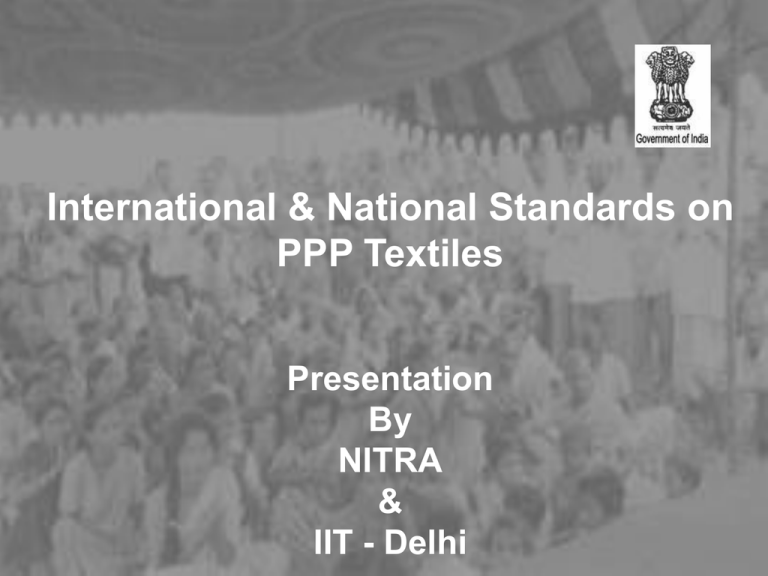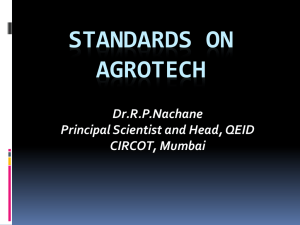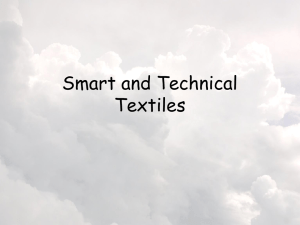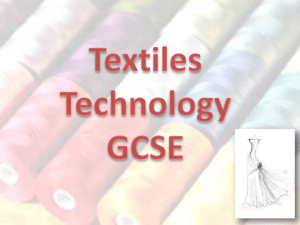Safe Public Places thro` FR Textiles
advertisement

Safe Public Places thro’ FR Textiles International & National Standards on PPP Textiles Presentation By NITRA & IIT - Delhi Personal & Property Protection (PPP) Textiles • Fire Retardant (FR) Textiles • High visibility warning clothing/Foul weather clothing • Ballistic protective clothing they would have been with us…. had there been FR Textiles… 83 children killed in school fire in Kumbakonam Victims of Uphaar Tragedy Fabric flammability is an important issue, especially for public spaces…. schools hospitals hotels theatres special event venues…. Importance of FR Textiles For Public Safety • In about 24 % of fire accidents, the first item to catch fire is textiles – 28% casualties were due to burns; – 48% due to smoke/gas; – 13% due to combined effects of burns, gas and smoke; – 11% due to other causes. Therefore a strong need exists to implement standards on FR textiles by enacting and enforcing fire safety legislation and guidelines specially for the public places/buildings and for children wear. L I F E S A V I N G S E C O N D S…. Standards- Protective Textiles AFTER 5 SECS SYNTHETIC BLENDED FABRIC COTTON BLENDED FABRIC AFTER 15 SECS AFTER 30 SECS Compiled by Pawan Sharma PYROGUARD FABRIC SYNTHETIC BLENDED FABRIC COTTON BLENDED FABRIC PYROGUARD FABRIC SYNTHETIC BLENDED FABRIC COTTON BLENDED FABRIC PYROGUARD FABRIC Technology of FR Textiles • Specialty fibers – not manufactured in India & expensive • Chemical finishing on conventional fibers – less expensive – Additional cost of Rs 30 to 100 per mt depending upon the quality requirement Evaluation Parameters for FR Textiles • • • • • • • • • • • • Ease of Ignition After Glow Time Extent of After Glow Char Length Flame Spread Time, Debris or Drips Smoldering Time Limiting Oxygen Index Heat Transmission Factor Heat Transfer Index Molten Metal Splash Index Smoke Opacity Toxicity US Regulations on FR Fabrics US Flammable Fabrics Act (codified at 15 U.S.C 1191-1204) • It keeps away the use of dangerously inflammable textiles out of commerce • It covers trading of fabrics meant for apparel or interior furnishing when they are traded with importers in USA • Manufacture, sale & importing of flammable fabrics into USA shall be prohibited • Importers are advised to buy from a supplier issuing a guarantee and a test report • Consumer Products Safety Commission is vested with the powers of determination of – authority to test, testing standards & prosecution powers USA Flammable Fabrics Act • Enforcement mechanism: – Consumer Products Safety Commission administers the enforcement mechanism – Imported fabrics are not allowed to be cleared out of customs warehouse unless it is FR – In case imported fabrics are released against bond by customs ware house, they can order for return to customs warehouse – Can seize and send for testing – File civil suit based on lab report – Levy fine up to $ 100,000 – Penalty is based on gravity of injury that would have caused or likely to have caused – In the event of misrepresentation, the merchant is liable for imprisonment up to 5 years. U S National Standards (Test methods) Developed by National Fire Protection Association NFPA 701: Standard Methods of Fire Tests for Flame Propagation of Textiles and Films. The fabric is tested by burning a small sample and measuring the flame, char length & flaming residue – if a fabric meets these three areas, it is considered as flame retardant. State and Local Regulations • Though NFPA 701 is the national standard, it is not a law or regulation in itself. • Authority to make and enforce laws and regulations in this area is granted to state and local governments. • Many state and local governments have not developed their own standards. Instead, they require that draperies used in public spaces meet the NFPA 701 standard. U S State and Local Regulations Some states and cities, however, have developed their own standards and/or procedures. These requirements are separate and distinct from NFPA 701 standards. State and Local Regulations In California, for example, drapery used in public spaces must be made of fabric that has been registered with the State Fire Marshal, documenting compliance with Title 19 (Division 1, Chapter 8) of California Code of Regulations. While the State of New York and the Commonwealth of Massachusetts both accept NFPA 701 certification, New York City requires certification that fabrics meet requirements outlined in Title 27 (Chapters 1 and 4) of the New York Administrative Code, while the City of Boston requires that the end users submit an application for a “use permit”, in advance, for each fabric to be used in a public space. State and Local Regulations Venue Requirements Even specific venues have developed their own requirements for drapery to be utilized within the venue. Radio City Music Hall, in addition to requiring that all fabrics be certified compliant with New York City regulations, also requires the Certificate of Flame Retardancy include not just basic information on the fabric utilized, but specific information about each sewn drapery piece, including quantity and size. European Standards Guide list & web site Protection Function Standard Code Protective Clothing Against Heat & Flame EN 531 For use in welding and allied processes EN 470-1 Against mechanical impact EN 510 For users of hand-held chainsaws EN 381- series Firemen’s Protective clothing EN 469 Against cold EN 342 Against foul weather (Moisture, wind, cold) EN 343 Against radioactive contamination EN 1073 Against electric hazards/electrostatic charges EN 1149 Against thermal hazards of an electric arc CLC/TS 50354 (technical specs) High visibility warning clothing EN 471 For working in environment of machines EN 510 Against chemical hazards EN 465,, EN 466, EN 467 http://www.cen.eu/cenorm/standards_drafts/onlinecataloguewithlinkstomem bers/index.asp Great Britain The Consumer Protection Act (1987), the Furniture and Furnishing (Fire) (Safety) Regulations 1988, 1989 & 1993 set levels of fire resistance for upholstered products. Standards Mentioned : BS 5852, BS 7177, BS EN 1021-2, BS 7176 • The first Regulation in Italy concerning fire behavior of Textiles e.g. Furnishings, had come in the existence in 1984 for the public assembly places like cinema halls, theaters etc. • Then restrictions for schools, fairs and hotels followed Italy FRANCE Upholstered Furniture in French public buildings has to meet ERP Article AM 18 which, since 2006, requires a finished testing as per the standard EN 1021 and French Standards NF D60 – 013 & NF D60 – 015. Application field and Fire standards Upholstery BS 5852 EN 1021 BS 7176 Flame Cigarette Crib 5 Mattress ticking BS 6807-1/2 EN 597-1/2 BS 7175 BS 7177 Flame Cigarette Crib 5 Carpet DIN 4102 (B1), FAR25-853 Black –out NF P92 503 Curtains BS 5867 type A type B type C NF P92 503 Bedding TB-604 Protective clothing EN 533, NF P92 503 (M1) Toys EN 71/2 Non woven NF P92 503 Fire Service Law of Japan requires that Flame Retardant items e.g. Carpets, Curtains etc. should have flame retarding treatment before going to the end users. JAPAN BIS Standards on FR Textiles • BIS has brought out a series of standards for FR textiles - curtains, drapes, upholstered furniture materials, protective clothing for industrial workers and fire fighters etc along with test methods for evaluation of the above items. • These standards are for 3 hazard categories – low hazard – moderate hazard & – high hazard categories Common FR Test Methods Cigarette Burning Test Match Test Carpet Testing Upholstery Test Recommendations… • In view of public safety and property loss as well as high environmental pollution involved in fires, it is necessary that relevant Indian standards are made mandatory for textiles used in public places / buildings - hospitals, schools, airports, theaters, shopping complexes, railways, civil aviation, automobiles etc. • Legislation for FR textiles are already in force in many of the developed countries of the world and India should be no exception to this. RECOMMENDATIONS… • IS Standards on FR textiles could be made mandatory under the BIS Act. • Standards developed by BIS on FR textiles need to be included in National Building Code of India 2005 immediately as a separate chapter. • In order to prevent the import of sub-standard and hazardous FR textiles, the relevant Indian standards could be made mandatory for imports also. RECOMMENDATIONS… • Ministry of home affairs may take up appropriate steps to introduce legislation in the parliament where by FR fabrics shall be mandatory in public places – hospitals, schools, auditoriums, cinema halls and places where lot of persons converge. This shall be a central legislation to be administered by state governments like Indian Penal Code, Code of Civil Procedures, Indian stamp Act. • Alternatively, Ministry of Home affairs may issue circular/draft legislation to all state governments & Union Territories for enactment of appropriate legislation measure. High-Visibility Warning Clothing Performance Requirements of High Visibility Materials • Color • Retro reflection- during night • Fluorescence- during day High Visibility Garment Classification It is based on assessing the extent to which the wearer is exposed to Risk • Task load • Nature of work • Color and complexity of the work • Environment • Lighting Factors deciding Garment Classes • Speed & Amount of Traffic through the Work zone • Time of Day - day or night? • Worker’s attention - towards on-coming traffic or the task at hand? • Type of Activity the Worker is Performing • Proximity to traffic & other construction vehicles • Location of Work - “Background Clutter” in the Work zone • Amount of Activity in the Work zone - Other construction vehicles, etc. Factors deciding Garment Classes Performance Class 1: • For low-risk environments - Lowest levels of fluorescent and reflective materials Performance Class 2: • Environments that are moderately severe Balance of fluorescent and reflective materials Performance Class 3: • For use in most severe environments Offers the greatest amount of fluorescent and reflective coverage Classification - Class 1 • For workers in occupations that permit full and undivided attention to approaching traffic; • when backgrounds are not complex; • when workers on foot are separated from traffic; & • when vehicles are moving at speeds not exceeding 25 mph. Classification- class 2: • • • For workers who require greater visibility under inclement weather conditions; when backgrounds are not complex; & when tasks divert attention from approaching vehicle traffic. Classification- class 2: • • • • Greater Visibility Needed due to Inclement Weather Conditions Complex and Cluttered Backgrounds Most Work is Performed during Daytime Hours Worker’s Attention is Diverted from OnComing Traffic and Surrounding Environment Classification- class 3 • • • • • Anyone who has a high task load and is in close proximity to moving equipment or traffic at high speeds Work Occurs at Night Worker’s Attention is Diverted from OnComing Traffic and Surrounding Environment “Cluttered” Work Zone with High Levels of Activity Worker has no separation between them and traffic Classification- class 3 • • For workers on foot and vehicle operators whose high task loads place them in danger; when the weather must be clear through the full range of body motions at a minimum of 390 m and when the wearer must be identified as a person. Worker must be Visible from All Angles and Identifiable as a Person Recommendations • At present statutory requirement is not in force for work places; except in few institutions such as A A I, Railways, DMRC etc. • Dress code should be strictly followed for those working in risky environments; appropriate IS standards (as per EN 471) have been formulated and Ministry of Home affairs should ensure compliance to the safety guidelines for which designated authority may also be notified. Ballistic Vest Ballistic Vest A ballistic vest or bulletproof vest is a protective clothing that absorbs the impact from firearm -fired projectiles and shrapnel fragments from explosions, on the wearer's torso. Soft vests are made from many layers of fabric to protect from projectiles of certain calibers fired from handguns, shotguns & small fragments from hand grenades. If metal or ceramic plates are used with a soft vest, it can also protect from shots fired from rifles. It can offer some protection against stab and slash from a knife. Soft vests are commonly worn by police forces, private citizens and private security guards or bodyguards. Hard-plate reinforced vests are mainly worn by combat soldiers in the armies of various nations as well as police tactical units and hostage rescue teams. Vests intended for police and military use may also include ballistic shoulder, and side protection armor components. Bomb disposal officers wear heavy armor and helmets with face visors and spine protection Bullet Proof Jacket The bullet-proof jacket protects the bearer by dissipating the kinetic energy of the projectile into the equipment layers by deformation of the fabric layer cutting across yarns. • • • • Light weight (around 5 Kg) Comfortable to wear Facilitate body movement Ability to spread the projectile energy efficiently Bullet proof vest is made from Kevlar fabric which belongs to Nylon (polyamides) family. It has unique “impact” characteristics. Kevlar Under Impact a) Carbon Fiber After Impact b) Kevlar After Impact c) Hybrid of Carbon Fiber and Kevlar After Impact Body Armor • Body, hand, wrist, and elbow armor are now made of Carbon composite with Kevlar as reinforcement to increases impact resistance. • Kevlar with Shear Thickening Fluid (STF) is the new improvement in body armor. It can take the same amount of impact, but with less layers, which makes the armor lighter and stronger. Kevlar Treated with Shear Thickening Fluid (Spike Stab Test) Market dynamics and key growth drivers • With the rising trend of crime, violence and terrorism the demand for bulletproof jackets is rising as well. • The major customers are Defence, Paramilitary forces engaged in counter terrorism/insurgency operations and Law enforcement agencies. • Despite high demand there have been very few suppliers in the market. • Indian Army alone can use up to 2 Lac pieces per annum given assured supply and realistic prices. However the supply is not adequate. U S Specifications National Institute of Justice specification (NIJ) U.S. Department of Justice • Personal body armor covered by this standard is classified into five types (IIA, II, IIIA, III, IV) by level of ballistic performance. • In addition, a special test class is defined to allow armor to be validated against threats that may not be covered by the five standard classes. Classification of Ballistic Vests Armor Level Protection Type IIA (9 mm; .40 S&W) against 8 g. 9x19mm Parabellum Full Metal Jacketed Round Nose (FMJ RN) bullets at a velocity of 373 m/s and 11.7 g .40 S&W Full Metal Jacketed (FMJ) bullets at a velocity of 352 m/s Type II (9 mm; .357 Magnum) against 8 g. 9 mm FMJ RN bullets at a velocity of 398 m/s and 10.2 g .357 Magnum Jacketed Soft Point bullets at a velocity of 436 m/s Type IIIA (.357 Sig; .44 Magnum) against 8.1 g .357 SIG FMJ Flat Nose (FN) bullets at a velocity of 448 m/s and 15.6 g .44 Magnum Semi Jacketed Hollow Point (SJHP) bullets at a velocity of 436 m/s Type III (Rifles) against 9.6 g 7.62x51mm NATO M80 ball bullets at a velocity of 847 m/s. Type IV (Armor Piercing Rifle) against 10.8 g .30-06 Springfield M2 armor piercing (AP) bullets at a velocity of 878 m/s Recently Ministry of Home Affairs finalized the technical specification of Light Weight Bullet Proof Jackets as per NIJ Standard of Ballistic Resistance of Personal Body Armour (NIJ Standard -010104) – Threat Level III A Assam Rifles, BSF, CISF, CRPF, ITBP, NSG, SSB, BPR&D The government has agreed to demands of the police for improved quality of bullet proof jackets but there may be problems in delivery. "We need nearly 1,00,000 more such jackets. It will take another one year when we will have bullet proof jacket with improved qualitative requirements. It will be by end of year 2009," said Bureau of Police R& D Chief K Koshy. Center of Excellence (Protech) NITRA & IIT-D Vision Statement Committed to assist Indian textile industry to venture in technical textile manufacturing (Protech) by way of providing world class services in • Testing • Training • Information & knowledge sharing Services to the industry Facilities for testing and evaluation of products: • The common testing facilities will be set up as per international standards such as ASTM, BS, DIN, ISO, EN etc. • These facilities will cater to the requirement of testing the final product and also the raw material and other elements that go into the final product Services to the industry National & International accreditation The testing laboratories will get national accreditation by NABL and also get accredited by international institutes so that the test results are accepted in the international market. Services to the industry Resource center with IT infrastructure: • Technical & Trade related literature – Text books, research journals & periodicals, international standards for testing & product specifications, trade magazines, directories of national and international manufacturers etc. • Show room – display of products • Dedicated website on Protech Services to the industry Training of core personnel: • Textile technologists, academicians, scientists and industry personnel. • Develop a set of core professionals (trainers) to impart training to the complete range of persons who are engaged in the business of Protech. • The core professional will be trained by internationally reputed consultants in the areas of knowledge, technology and application. Services to the industry Training of personnel from the industry: • Facilities for regular training of technicians working in the industry. • The CoE will also study the requirement of the training from the clusters and will set up satellite training facilities in such clusters to facilitate the technicians to attend the training programs.







